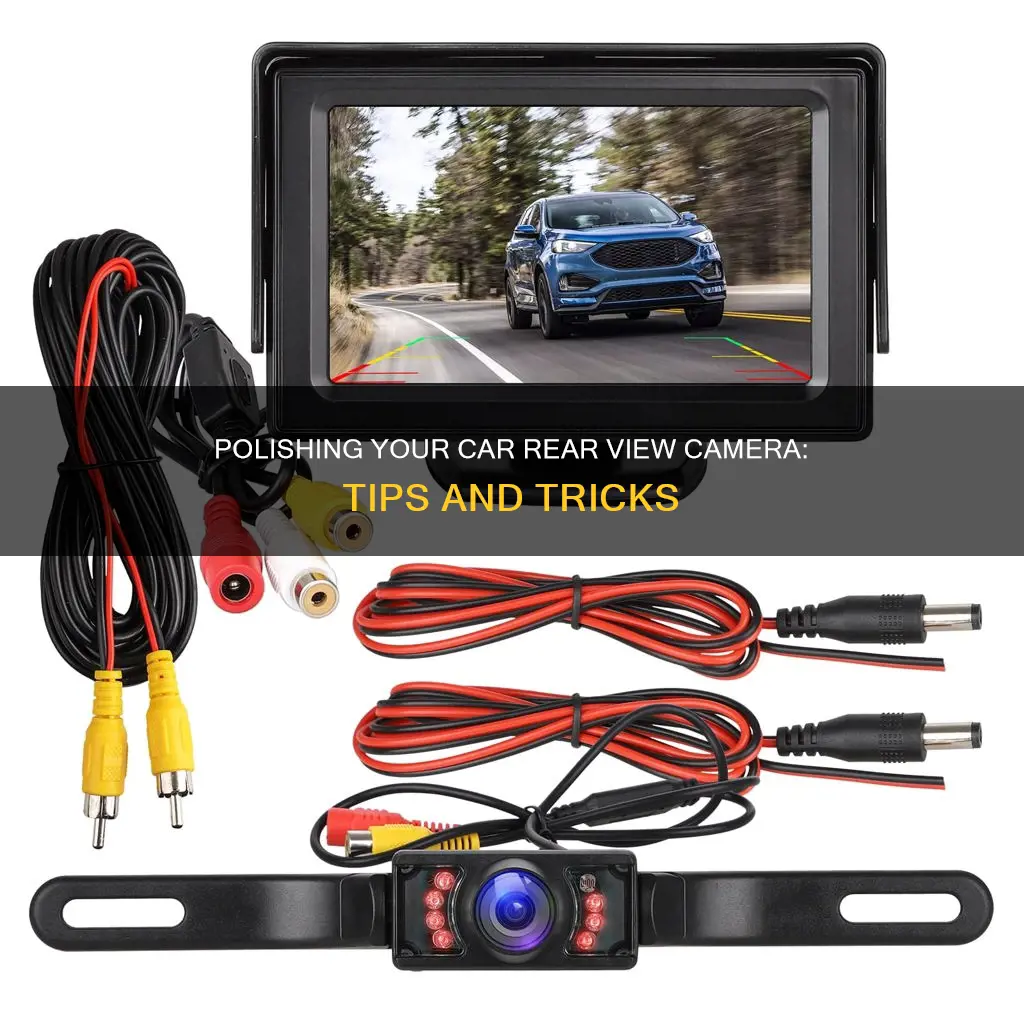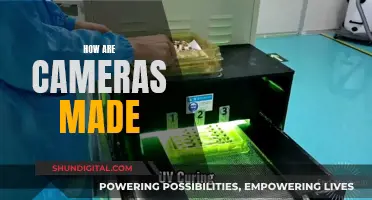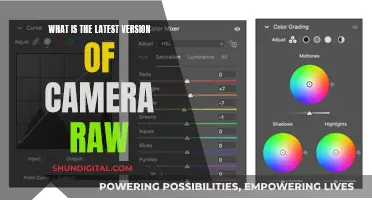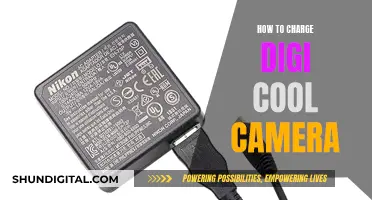
Keeping your car's rear camera clean is important for safety and peace of mind. A blurry or fuzzy image can be caused by a dirty or scratched lens. To polish your car's rear camera, you can use a variety of methods, from a simple lens cleaner to a more intensive process involving sanding and polishing. It's important to note that different cameras have different qualities, but regardless of the quality level of your lens, it’s best to utilize lens-cleaning best practices.
How to Polish a Car Rear Camera
| Characteristics | Values |
|---|---|
| Cleaning tools | soft-bristled brush, microfiber cloth |
| Cleaners | isopropyl alcohol, lens cleaners (not acetone-based) |
| Polishing tools | 2000 grit wet-dry sandpaper, 3000 grit wet-dry sandpaper, microfiber cloth |
| Polishing compounds | Meguiars Ultimate Compound, Meguiars #10, toothpaste (not gel) |
| Protection | wax, sealant |
What You'll Learn

Use a soft-bristled brush or a microfiber cloth to wipe away dust and grime
To polish your car rear camera, you'll want to start by giving it a good clean. Over time, dust and grime will accumulate on the lens, and it's important to remove this before attempting to polish the camera.
The best tool for this job is a soft-bristled brush or a microfiber cloth. Both of these options are soft enough that they won't risk scratching the lens, but they will effectively wipe away any dust and grime that has built up. If your camera lens is particularly dirty, you may want to dampen your cloth with water before wiping down the lens. Be sure to use a gentle touch when cleaning the lens, as it can be delicate. Take your time and be thorough, ensuring that you cover the entire lens surface.
It's important to clean your car rear camera lens regularly, as dirt and grime can accumulate quickly, especially if your car is often driven on dusty roads or parked in a dirty environment. A quick wipe-down with a soft-bristled brush or microfiber cloth can help to maintain clarity and ensure that your camera is always in optimal condition.
In addition to regular cleaning, you may also want to consider using a protective lens cover or a coating of car wax to help keep your camera lens in good condition. This will create an extra barrier between the lens and the elements, reducing the amount of dirt and grime that accumulates and making it easier to clean.
By following these simple steps and maintaining a regular cleaning routine, you can help ensure that your car rear camera remains clear and functional for years to come.
Focusing on Dual Subjects with Your Camera
You may want to see also

Spray with a cleaner like isopropyl alcohol
To polish your car's rear camera, you can use a cleaner like isopropyl alcohol. Here's a step-by-step guide:
- Park your car in a shaded area, away from direct sunlight, and allow the rear camera to cool down if it has been exposed to high temperatures.
- Inspect the rear camera lens for any dirt, debris, or residue. Use a soft, clean microfiber cloth to gently wipe away any loose particles.
- Spray a small amount of isopropyl alcohol onto a separate, clean microfiber cloth. Ensure that the cloth is damp but not dripping wet.
- Gently rub the damp cloth in a circular motion over the rear camera lens. Apply light pressure and work your way across the entire surface of the lens.
- Use a dry corner of the cloth or a new, dry microfiber cloth to buff the lens until it is dry and streak-free.
- Inspect the rear camera lens for any remaining dirt or smudges. Repeat the process if necessary, being careful not to apply too much pressure or use a harsh rubbing motion.
- Finally, test the rear camera to ensure it is functioning properly and that your visibility is improved.
Isopropyl alcohol is a common cleaner for camera lenses and is generally safe to use. However, it is always a good idea to refer to your car's user manual or seek advice from a professional detailer if you are unsure about the products and techniques to use on your specific car model.
Hacking Surveillance Cameras: A Step-by-Step Guide
You may want to see also

Wipe with a microfiber cloth using gentle circular motions
To polish your car rear camera, you'll want to wipe it with a microfiber cloth using gentle circular motions. This is a delicate process, so be sure to apply only gentle pressure as you work.
Before you begin, ensure that you have the right tools for the job. A good-quality microfiber cloth is essential for effective and scratch-free cleaning. Look for one that is soft and absorbent, preferably designed for cleaning camera lenses or delicate surfaces. You can find these cloths at photography stores or online.
Now, let's get into the steps for the actual polishing process:
Prepare the Camera Surface:
Start by using a soft-bristled brush or the microfiber cloth to gently wipe away any dust, dirt, or debris on the camera lens. This initial step will help prevent scratches that could be caused by particles on the lens as you polish.
Spray the Cleaner:
Lightly spray your chosen cleaner onto the lens. There are specially formulated lens cleaners available, but a simple and effective option is to use isopropyl alcohol. Avoid cleaners with acetone as it can damage the protective coatings on your camera lens.
Wipe with a Microfiber Cloth:
This is the key step we're focusing on. Using your microfiber cloth, gently wipe the lens in a circular motion. Keep your movements slow and deliberate, ensuring you cover the entire surface of the lens. The microfiber cloth will pick up any remaining dust and debris while also removing smudges and streaks.
The key here is to be gentle and patient. You may need to repeat the process a few times, especially if the lens is particularly dirty or foggy. Work in those gentle circular motions, applying light pressure, until the lens is clear and streak-free.
Once you've finished polishing, take a step back and admire your handiwork! A clean and polished car rear camera can make a big difference when it comes to visibility and safety.
Mounting Cameras on Remote Control Cars: A Step-by-Step Guide
You may want to see also

Check connections between the display and camera
When connecting a rear-view camera, it is important to ensure that the power supply is correct and stable. Incorrect power supply can damage the camera or the car's wiring and cause issues with the camera's functionality and image quality. Here are some detailed steps to check the connections between the display and the camera:
- Understanding Power Requirements: Before connecting the camera, understand the power requirements of both the camera and the display. Check the minimum voltage threshold of the camera, as you may need a power converter to ensure the correct voltage.
- Identify the Power Source: Identify a suitable power source for the camera. In many cars, the OEM rear-view camera is designed to turn on when the ignition is turned on, providing a warmed-up matrix and a perfect image, especially at night. You can connect the camera's power to the same source, ensuring that the "+" and "-" are taken from the same place, which is crucial in electronics connection.
- Use a Power Converter if Needed: If your camera requires a specific voltage, use a power converter to adjust the voltage accordingly. Select the appropriate converter based on the power requirements of your backup camera.
- Connect to Reversing Lights: If your rear-view camera activates when shifting into reverse gear, you can connect it to the reversing lights. If there are clear "+" and "-" connections, you can connect the power directly to the reversing lights.
- Handle Pulsating Signals: In some cars, the signal on the reversing lights is pulsating to check if the bulbs are working. If you encounter a pulsating signal, you will need to use a filter to even out the signal. A capacitor can be used for this purpose, but make sure to separate it from the system using an LED to avoid transmitting the evened-out signal back to the bulbs and the on-board computer.
- Avoid Common Mistakes: It is important to avoid common mistakes when connecting the power. Do not take the "+" from the reversing lights and the "-" from the chassis, as this will create a potential difference and cause voltage fluctuations. Always take the power from the same source.
- Test the Camera: Once you have made the connections, test the camera to ensure it is working correctly. If there are issues with the display, check the activation settings in the factory menu and adjust the DIP switches if necessary.
- Use a Video Interface: If you are connecting an aftermarket rear-view camera to an OEM display, you will typically need a video interface. This is also useful if you want to connect aftermarket navigation systems or video sources. A video interface allows you to adjust activation methods and ensure the camera activates when shifting into reverse gear.
- Identify the Monitor: When using a video interface, correctly identify the size, resolution, type, and manufacturer of the monitor. Put the DIP switches in the corresponding positions as per the manual.
- Identify the Camera: Set the correct position of the DIP switch for camera identification. If you are connecting an aftermarket camera, ensure the video interface identifies it and activates the image display when reversing.
- Match Video Systems: Ensure that the video system of the camera and the car multimedia system are the same. If they are not, purchase a camera that supports your car's video system or use a converter.
Focusing on Infinity: Cameras and Their Limitations
You may want to see also

Use a desiccant like heated uncooked rice to remove moisture
If your car's rear camera is blurry or foggy, it might be time to give it a good clean. But before you grab your cleaning supplies, it's important to identify the cause of the problem. In some cases, a blurry camera display may not be due to a dirty lens but rather an issue with the system's wires and connections. So, check for any signs of damage, such as split or disconnected wires, and rule out the possibility of a blown fuse by checking your vehicle's fuse box.
Now, if you've determined that the issue is indeed a dirty lens, here's where uncooked rice comes in. Disconnect the camera and submerge it in a desiccant like heated uncooked rice. This step is crucial, especially if condensation or debris has made its way behind the camera lens. The desiccant will work its magic by absorbing any moisture from the electronic components, thanks to the process of adsorption. This is where the uncooked rice comes in—it's a desiccant!
Here's how to do it:
First, gather a sufficient amount of uncooked rice. You want to make sure you have enough to completely surround the camera. Prepare the rice by heating it up. This step is important because the heat will help activate the rice's moisture-absorbing properties. Once your rice is nice and toasty, it's time to submerge your camera. Place the disconnected camera in a container and fill it with the heated rice, making sure the rice is in direct contact with the camera.
Leave the camera in the rice for at least 24 hours. During this time, the rice will act like a sponge, absorbing any moisture that may be causing the foggy appearance on your camera lens. The heating process beforehand ensures the rice is ready to absorb as much moisture as possible, improving its effectiveness.
After 24 hours, retrieve your camera from its rice bath. The condensation and moisture should now be significantly reduced, if not completely gone. Before reinstalling your camera, take this opportunity to give the lens a gentle clean using a soft cloth and isopropyl alcohol, or just water, as recommended by many automakers.
And there you have it! A simple, cost-effective solution to a foggy car rear camera using a desiccant like heated uncooked rice.
Fighting Camera Tickets: Is It Worth the Effort?
You may want to see also
Frequently asked questions
First, use a soft-bristled brush or a microfiber cloth to wipe away any dust, grime, or debris. Then, spray with a cleaner such as isopropyl alcohol and wipe away with a microfiber cloth using gentle circular motions.
Avoid using cleaners with acetone as a primary ingredient, as it can erode the protective coatings on the camera lens.
Check the connections between your camera and display, ensuring that the cables are seated properly and not split or disconnected. If there are any fraying wires, use electrical tape and a splicing tool to fix them.
Check for condensation or debris behind the camera lens. If present, disconnect the camera and submerge it in a desiccant like heated uncooked rice to absorb moisture from the electronic components.
It might be time to upgrade to a new camera. There are a variety of options available, including wireless and wired cameras designed for different makes and models of cars and trucks.







